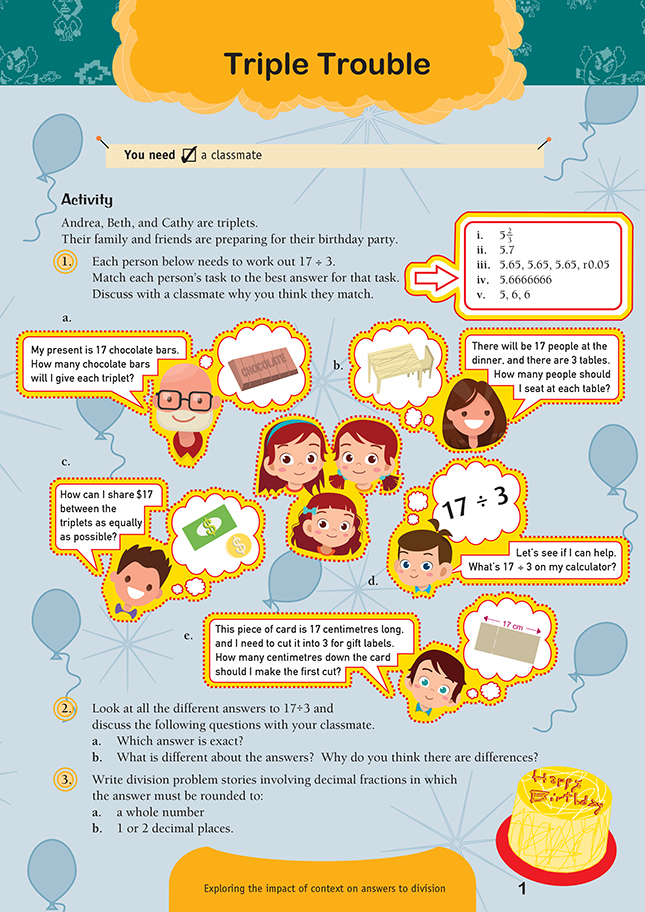This is a level 4 number activity from the Figure It Out series. It relates to Stage 7 of the Number Framework.
A PDF of the student activity is included.
Click on the image to enlarge it. Click again to close. Download PDF (278 KB)
solve division problems involving remainders
Number Framework Links
Use this activity to help your students to extend their advanced multiplicative part–whole strategies (stage 7) and advanced proportional strategies (stage 8) in the domain of multiplication and division.
FIO, Level 3, Number Sense and Algebraic Thinking, Book Two, Triple Trouble, page 1
A classmate
This activity encourages students to think about how the remainder in a division problem can be treated differently according to the context. Students need to be at least advanced multiplicative thinkers (stage 7) to do this activity independently. However, advanced additive students can learn more about division by attempting the activity. They need to be familiar with fractions and decimal fractions, including how to round a decimal fraction to 1 or 2 decimal places.
You may need to define the term “decimal fraction”, more commonly called a decimal. The term refers to a numeral that uses base 10 place values, such as tenths and hundredths, and a decimal point to name a fraction.
With a guided teaching group, you could present question 1 as a practical activity, particularly if the students are not yet confident about using stage 7 strategies in division. Give each pair in the group one of the problems to solve using equipment:
• For a: 17 “chocolate bars”, each made of 3 (or 6) multilink cubes
• For b: 17 counters to represent the people and 3 pieces of paper to represent the tables. (This pair could also do problem d, which will not take long.)
• For c: $17 in toy money. (You will also need to have coins available for them to make exchanges.)
• For d: a calculator
• For e: a 17-centimetre piece of card to fold, a ruler, and some scissors.
Ask each pair to report back their findings and to demonstrate to the others what they did with their equipment to solve the problem. Record the different answers each pair came up with, for example, 5.7 centimetres or $5.65 with 5 cents left over.
Get the students to look at the box of answers in the student book. Ask the students questions such as:
Which answer in the list is best for the task that you did? Give reasons for your choice.
Are there any answers in the list that are suitable for more than one problem?
You can use question 2 to ask questions that promote algebraic thinking. All the answers in question 1 are ways of handling 17 ÷ 3, but whether they are “correct” depends on the context of the problem. For example, 5 2/3 is the result of dividing 17 by 3. When we attempt to write this as a decimal fraction, we get 5.666. We can’t work with an infinite string of 6s, so we approximate. The way we approximate always depends on the circumstances. We use only as many decimal places as we want to or can. Sometimes it isn’t appropriate to use fractions or decimal fractions because the items (for example, people) cannot or should not be shared into parts. In such cases, we round the answer up or down to the nearest whole number.
Question 3 is a useful formative assessment point to see whether the students understand which contexts are suitable for whole number answers and which ones require 1 or 2 decimal places. Remind the students that the calculation could involve decimal fractions that have to be rounded, such as 13 ÷ 3 or 22 ÷ 7, or finite decimals, such as 19 ÷ 4 = 4.75. The students may need to use a calculator to help them find a problem that has an answer with many decimal places.
If the students are having difficulty thinking of contexts, ask the group to brainstorm things that shouldn’t be broken up into pieces, such as people, animals, cars, or items of clothing, and things that you can measure to 1 or 2 decimal places, such as people’s height in metres, distance travelled in kilometres, dimensions of a sheet of paper in centimetres, weight of food in kilograms, or liquid in litres.
Extension
Have the students investigate the Swedish rounding system used in supermarkets. They could also design a flow chart that explains the decisions involved in rounding a decimal fraction to 2 decimal places. Question starters for the flow chart could include:
Does your decimal fraction have more than 2 decimal places?
Is the number in the hundredths place greater than or equal to 5?
Answers to Activity
1. a. i. 5 chocolate bars
b. v. 5, 6, and 6 people
c. iii. $5.65, $5.65, $5.65, r5c. ($5.65 each and 5c left over)
d. iv. 5.6666666 (on a calculator with 8 places)
e. ii. 5.7 cm
2. a. 5 . (5 x 3 = 17)
b. Answers will vary. The numbers differ in how close they are to exactly 5 2/3. They have been rounded differently because of the different contexts. For example, we don’t use 1c and 2c coins any more, so the friend will have to round her amounts
to $5.65; most calculators display 8 digits; the number of pieces in a chocolate bar may be exactly divisible by 3.
3. a.–b.
Problems will vary. The story with a whole number answer should involve
things that are not normally broken up into parts, such as people, animals, or
cars. The story with an answer rounded to 1 or 2 decimal places might involve
measuring weight, length, or volume.
